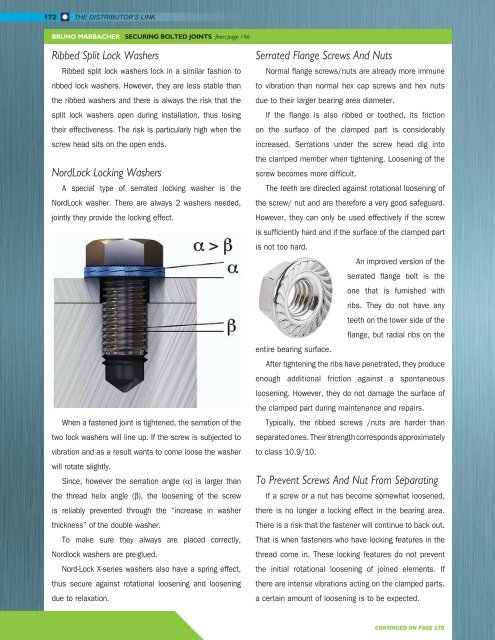WINTER 2024
Distributor's Link Magazine Winter 2024 / Vol 47 No 1
Distributor's Link Magazine Winter 2024 / Vol 47 No 1
Create successful ePaper yourself
Turn your PDF publications into a flip-book with our unique Google optimized e-Paper software.
172<br />
THE DISTRIBUTOR’S LINK<br />
BRUNO MARBACHER SECURING BOLTED JOINTS from page 146<br />
Ribbed Split Lock Washers<br />
Ribbed split lock washers lock in a similar fashion to<br />
ribbed lock washers. However, they are less stable than<br />
the ribbed washers and there is always the risk that the<br />
split lock washers open during installation, thus losing<br />
their effectiveness. The risk is particularly high when the<br />
screw head sits on the open ends.<br />
NordLock Locking Washers<br />
A special type of serrated locking washer is the<br />
NordLock washer. There are always 2 washers needed,<br />
jointly they provide the locking effect.<br />
When a fastened joint is tightened, the serration of the<br />
two lock washers will line up. If the screw is subjected to<br />
vibration and as a result wants to come loose the washer<br />
will rotate slightly.<br />
Since, however the serration angle () is larger than<br />
the thread helix angle (), the loosening of the screw<br />
is reliably prevented through the “increase in washer<br />
thickness” of the double washer.<br />
To make sure they always are placed correctly,<br />
Nordlock washers are pre-glued.<br />
Nord-Lock X-series washers also have a spring effect,<br />
thus secure against rotational loosening and loosening<br />
due to relaxation.<br />
Serrated Flange Screws And Nuts<br />
Normal flange screws/nuts are already more immune<br />
to vibration than normal hex cap screws and hex nuts<br />
due to their larger bearing area diameter.<br />
If the flange is also ribbed or toothed, its friction<br />
on the surface of the clamped part is considerably<br />
increased. Serrations under the screw head dig into<br />
the clamped member when tightening. Loosening of the<br />
screw becomes more difficult.<br />
The teeth are directed against rotational loosening of<br />
the screw/ nut and are therefore a very good safeguard.<br />
However, they can only be used effectively if the screw<br />
is sufficiently hard and if the surface of the clamped part<br />
is not too hard.<br />
An improved version of the<br />
serrated flange bolt is the<br />
one that is furnished with<br />
ribs. They do not have any<br />
teeth on the lower side of the<br />
flange, but radial ribs on the<br />
entire bearing surface.<br />
After tightening the ribs have penetrated, they produce<br />
enough additional friction against a spontaneous<br />
loosening. However, they do not damage the surface of<br />
the clamped part during maintenance and repairs.<br />
Typically, the ribbed screws /nuts are harder than<br />
separated ones. Their strength corresponds approximately<br />
to class 10.9/10.<br />
To Prevent Screws And Nut From Separating<br />
If a screw or a nut has become somewhat loosened,<br />
there is no longer a locking effect in the bearing area.<br />
There is a risk that the fastener will continue to back out.<br />
That is when fasteners who have locking features in the<br />
thread come in. These locking features do not prevent<br />
the initial rotational loosening of joined elements. If<br />
there are intense vibrations acting on the clamped parts.<br />
a certain amount of loosening is to be expected.<br />
CONTINUED ON PAGE 178
















